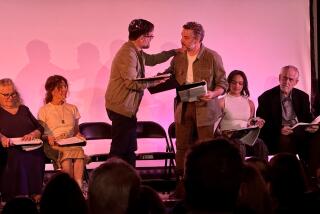Focusing on a Hot Spot
When politics heats up in the Middle East, courses like Middle East Government and Politics at Pierce College in Woodland Hills get hot too.
Enrollment in such classes jumps because students hear of unrest and seek further insight into the brewing conflicts.
âHopefully I will . . . see why people are fighting over there,â said David Aguilar, a student in the Pierce community college course.
âThe only thing I want to get out of it is, what would drive people to kill? Is it that a culture, a love for religion, would drive you to kill, or is it politics?â
Courses like these bring together people who might otherwise never meet, let alone talk politics in measured tones.
âI was very excited to see it in the catalog,â said Kenneth Scalir, a political science major who has attended Pierce on and off for six years. âThis is very good to learn why people disagree.â
At times, potentially volatile questions come up. In a recent session, the class discussed American mediaâs portrayal of conflicts in the Mideast, using a news article to initiate the debate.
Two students voiced opposing viewpoints.
âCNN doesnât show the violence against Israelis, just Israelis against Palestinians,â said Dorit Zohar, a 30-year-old Israeli.
Afghani Muslim student Marshal Nasiri, 18, countered, âWhat about the scene when the two Palestinian soldiers killed the Israeli man and threw him out the window?â The two were joined by other students airing views on each side until the emotions died down.
The two women later said they enjoy voicing their differences and hearing the other side. The class allows them to do both.
âIâm curious about peopleâs culture, peopleâs background, the way they think,â Zohar said. âIâm friends with the professor. Heâs one example of an Israeli Arab I can talk to.â
Nasiri said the debates--though sometimes tense--will engender understanding.
âYou try to argue with [classmates] but in no way do you feel threatened,â she said. âYou can see how they feel about the subject.â
With the recent Israeli-Palestinian clashes, enrollment in the Pierce course grew from 25 in the first class to 38 a week later, instructor Kassem Nabulsi said.
Students in the class--some from as far away as Egypt, Iran, Afghanistan and Israel--are intrigued by recent developments in the West Bank.
Since September, the region has been plagued by sporadic violence that has claimed more than 350 lives and disrupted peace talks.
Also stoking studentsâ interest was Israeli Prime Minister Ariel Sharonâs landslide victory in January over former Prime Minister Ehud Barak, said UCLA instructor Steven Spiegel, who has taught courses on the Middle East for more than 30 years.
âI think there is some revival of interest,â he said. âStudents often react to current events. Arab-Israeli issues have been getting a lot of coverage.â
By Spiegelâs estimate, interest in the Middle East is the highest it has been in 15 to 20 years.
At the time the course was started, about 20 years ago, many colleges and universities saw an increase in enrollment in courses on the Middle East. That was because of flare-ups in the region, including the war in Lebanon and the Iranian revolution.
Levon Marashlian, who teaches a course titled Modern Middle East at Glendale Community College, said many students were forced from their Middle Eastern homelands and later enrolled in Middle East studies courses in the United States.
Attendance in Marashlianâs course reached 51 in 1981--his first year of teaching it--compared with an average of 30 students in later years, he said.
About 15 years ago, the Pierce course was suspended for several years because of a lack of funding and interest. Then it was revived at the 16,400-student college for one semester in 1991 during the Persian Gulf War.
Teaching such courses, instructors say, requires a measure of self-restraint.
âObviously, I have my own opinions on a lot of issues,â Marashlian said. âWhat I stress is, what you need to do is know both sides. What I emphasize is for them to get both sides from those sides, not from me.â
Marashlian said he uses video footage of current events to teach the bulk of his class. If he cannot find news or television footage to support each side, he uses newspaper and magazine articles.
An Arab Israeli, Nabulsi said his background gives him a unique perspective from which to lead discussions.
âI try to be as objective as possible in giving the political overview,â Nabulsi said. âI have lived among both [Israelis and Palestinians]. I have been able to connect to the source of suffering for both.â
Nabulsi uses writing exercises to challenge studentsâ core beliefs and preconceptions. Standing before the ethnically diverse class on a recent Monday night, he assigned a brief exercise: Write what you view as your most important âcollective identity.â
Then he asked students to identify the group that most posed a threat to their collective identities. He told them they would learn to identify with the struggles on both sides of the conflict.
âAs political scientists, it doesnât matter what you teach,â said Norm Levy, political science department chairman at Pierce. âConflict is at the heart of our discipline.â
To some students, however, the Pierce course is simply a chance to broaden their horizons. âMaybe it will give me a better perspective on how to focus on the whole world,â said Gina Lin, a student of Chinese heritage.
More to Read
Sign up for Essential California
The most important California stories and recommendations in your inbox every morning.
You may occasionally receive promotional content from the Los Angeles Times.










